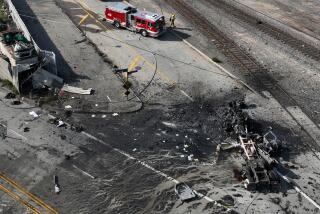Pumped Up
- Share via
Firetrucks could get a whole lot smaller with a new multipurpose device from an El Segundo inventor.
The cylindrical energy module, or CEM, is a hybrid pump and compressor and, with a few minor modifications, can also be used as an engine. Eddie Paul won a patent for his creation--slightly larger than a roll of paper towels--in 1993 but struggled for years to find a marketable application. Based on suggestions from several firefighters, Paul decided to turn his pump into a fire extinguisher.
In July, Paul traveled to Baltimore to conduct tests with a 115-pound prototype that fits easily into the back of a pickup truck. While the traditional fire engine was unable to extinguish a test fire after spraying it with water for an hour, the CFX--short for CEM Fire Extinguisher--put out a fire in less than a minute using water mixed with FireStopper foam, Paul said.
“Eddie’s pump is far more efficient than anything I’ve seen to date,” said James Morand, president and chief executive of EnviroFoam Technologies in Gilbert, Ariz., which sells fire-suppression products.
Traditional pumps use a turning crankshaft to move a piston up and down inside a single, stationary cylinder. Each revolution of the crankshaft produces one piston cycle.
The CEM has six cylinders arrayed lengthwise inside a symmetrical structure. As a motor spins, the CEM spins, a groove in its outer shell guiding the pistons back and forth inside their cylinders. By the time the CEM makes one full revolution, each piston has completed two cycles. And because the device has openings at two ends instead of one, each cylinder does twice as much work as those in traditional pumps.
When water or another liquid is coursing through the device, it works as a pump. If air is being pumped, it functions as a compressor. By attaching a spark plug to burn a mixture of fuel and compressed air, the CEM works as an engine.
For starters, Paul and his wife, Renee, are concentrating on the firefighting market. With its compact size and comparative efficiency, a single CFX unit could fit into a sport-utility vehicle with 250 gallons of water and spray foam for four hours in places that would be hard to reach with a firetruck. The Pauls are also exploring the firefighting benefit of loading a CFX into a helicopter.
Since displaying the CFX at the Fire Rescue International trade show in Dallas last month, Paul’s company, E.P. Industries, has been fielding inquiries from manufacturers and distributors. Although the fire industry is slow to adopt new technologies, potential buyers say the CFX can find several successful niches.
“You’d be able to add this on to a firetruck” so that it could fight fires with either water or foam, said Paul Darley, vice president of sales and marketing at W.S. Darley & Co., a Melrose Park, Ill., company that makes fire pumps and trucks and distributes firefighting equipment. “It certainly has some good potential.”
More to Read
Inside the business of entertainment
The Wide Shot brings you news, analysis and insights on everything from streaming wars to production — and what it all means for the future.
You may occasionally receive promotional content from the Los Angeles Times.










